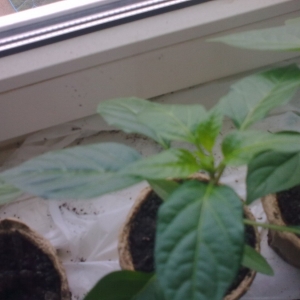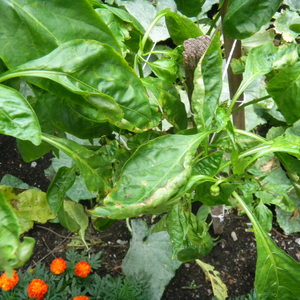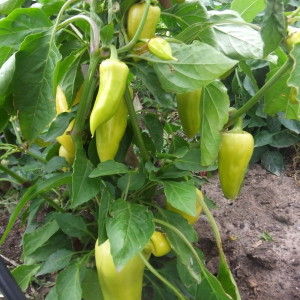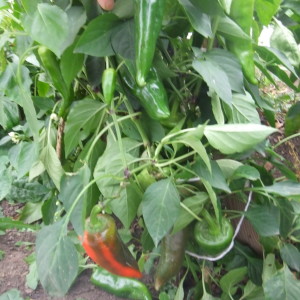Peppers are dropping leaves: what to do to save their plantings and prevent problems
Pepper is a demanding crop that reacts to the slightest errors in agricultural technology and weather changes. Growing it on their site, summer residents are faced with a whole range of problems. One of them is leaf fall. What to do if the leaves fall off the peppers? Correcting the situation is easy if you know the reason for the foliage reset.
The content of the article
Why is pepper leaves falling dangerous?
Falling green leaves is an unnatural process that is dangerous to plants. Their main respiration and nutrition occurs through the leaves. With a massive loss of leaves at any age (seedling or adult), the plant weakens and dies.
Possible reasons
You need to monitor the condition of the peppers daily, not only at the stage of growing seedlings. If you notice in time that the leaves changed the color form or completely fell green, it is possible to have time to take a set of necessary measures to eliminate leaf fall.
Agrotechnical errors
Gross violations in agricultural technology always affect the health of the plantings. It is important to properly care not only for young seedlings, but also for adult plants.
In case of insufficient and rare watering, the pepper "reports" the lack of water by its appearance. The leaves of the lower tier begin to turn yellow and fall off. With a strong overdrying, the whole plant "hangs" and drops buds and ovaries.
Strong stagnation of water and lack of air access to the root system impede normal air exchange between roots and crown. The roots in such a situation begin to rot. Often brown and black spots appear on the leaves, petioles and stems. The problem is most common in growing seedlings.
The problem can be caused by a deficiency of mineral nutrition:
- the plant reacts to a lack of nitrogen with a yellow leaf with white blotches;
- with a deficiency of potassium, the leaf blade turns yellow along the edge, deforms and twists down;
- if the plant lacks phosphorus, the surface of the leaf turns yellow, and the veins remain green;
- lack of iron causes yellowing of the upper leaves. With severe chlorosis, the leaves fall off.
Against the background of general starvation, not only the leaves, but also the ovaries of the pepper crumble.
Watering with running water from a hose negatively affects his health. Because of this, the root system is greatly supercooled and rotted. The leaves turn yellow and crumble, starting from the lower tier.
Pepper does not like to grow in cramped conditions. If the planting is too thickened, the roots of the seedlings become entangled with each other, depriving the necessary air, water, nutrition and rot. To survive in such conditions, plants are forced to throw off the excess mass of leaves, like ballast.
External factors
Bell pepper belongs to heat-loving crops, and any change in weather conditions - a drop in temperature, sudden temperature fluctuations, drafts, prolonged rains - can negatively affect its development. Most often, fragile seedlings suffer, just planted into open ground.

When it is planted in a permanent place, small roots are often damaged. In response, the plants slow down their growth and shed their lower leaves. This reaction continues for several days until the young peppers take root in a new place. The emergence of new young leaves and buds will be a signal of successful rooting. If this does not happen, the plants may have been deeply buried during planting.
Any sudden temperature fluctuations are dangerous, especially at night. Favorable temperature for the growth and development of pepper:
- daytime - + 23-25 ° С;
- night - + 18-20 ° С.
At a rate below + 14 ° C, it stops growing, and at night temperatures below + 12 ° C, the plants begin to fall out of leaves.
With a long and persistent heat, combined with dry air (this only applies to outdoor conditions and home seedlings maintenance), the leaves hang and fall green.
Reference. Pepper is bad not only from sharp jumps in temperature and nighttime cold snaps in the open field, but also when it drops in the greenhouse.
Pepper belongs to light-loving crops. The ideal place for planting seedlings is an area with full daylight. The light should be diffused. From exposure to direct sunlight, burns appear on the leaf blades, the leaves wither and fall off. Direct sunlight is the most dangerous for seedlings and seedlings that have just been planted in the ground.
Heavy, clayey or acidic soils are not suitable for normal pepper development. In such soil, its roots suffer from air and water metabolism disorders, freeze, stop growing and rot. The plants themselves look oppressed, weakened. Loss of leaves begins.
Reference. A neutral, light, breathable soil is considered ideal.
Pests
Pepper is attacked by many pests that suck the juice from the leaves, causing them to fall off. Root pests (nematode, bear) cause more damage to the planting of pepper, because when the gardener finds the cause, it is already too late. The main pests of pepper:
- Spider mite. A small insect that can be easily identified by the cobwebs that envelop the plant. With massive infection, the color of the leaves fades, acquiring a grayish tint. On the surface of each leaf, a network of punctured punctures forms - the places where the tick drank juices from the plant.

- Aphid... The leaves become shiny and sticky to the touch, turn yellow and crumble. When viewed from their lower side, colonies of small green insects are observed.
- Whitefly. Distributed in greenhouses. Small white butterflies, similar to moths, hide from the underside of the leaves and take off en masse when the bushes are shaken. The pest sucks the juices from the leaves, covering them with a sticky liquid, they turn yellow and fall off.
- Thrips. Small, oblong, dark brown beetle-like insect. Thrips are easy to distinguish from other pests by the nature of their flight - they seem to "jump" from one part of the plant to another. Larvae and adult thrips suck the juices from the pepper, leaving streaks and streaks behind them. The affected leaves fall off.
- Medvedka. Large soil pest. It gnaws at the roots, causing the entire plant to wilt and massive leaf fall.
Diseases
In order for the pepper to grow strong and healthy, it is important to timely prevent and treat emerging diseases. Among them are common:
- Verticillary wilting. It is caused by a fungus and affects peppers before flowering. Plants lag behind in growth, their internodes are deformed, leaves become smaller and crumble.
- Black spot. The bacterial infection progresses with high air humidity and lack of good ventilation. It causes the appearance of dark brown round spots with a yellow edging on the leaves, which then turn yellow and fly around.

- Late blight. The infected plant will fade green. A characteristic feature is rotting of the root collar and base of the stem. Brown spots appear on the trunk and foliage, which become covered with a whitish bloom in rainy weather. The disease does not respond to treatment, it is recommended to burn diseased bushes.
- Powdery mildew. Chlorotic spots covered with a powdery white bloom on top. When the disease progresses, the spots grow in diameter, the leaves turn yellow and fall off. The plant can be left completely without them.
- Lightning decay. Bacterial microorganisms, getting into the stalks of pepper, block the vessels, preventing food and water from reaching the parts of the plant. White mucus forms in the stems. The leaves turn yellow and fly around. The disease develops rapidly and does not respond to treatment.
- Bacterial cancer. The disease appears on fruits as black dots. The spots grow over time and merge into one large spot. Severely diseased specimens have discolored leaves that fall off when shaken.
Typical reasons
In open and protected ground, the causes of leaf drop in pepper can differ. In greenhouses, it is protected from unfavorable natural factors, but a small area, rarely replaced soil and constant air humidity lead to the development of fungal diseases.
For greenhouses
The greenhouse has a special microclimate, in which not only garden crops develop well, but also diseases. Saving space and improper ventilation affect the health of the pepper.
Reasons for leaf fall in the greenhouse:
- fungal diseases;
- thickening of landings;
- waterlogging of the soil;
- lack of ventilation;
- drafts.
For open ground
As long as pepper seedlings live on the windowsill, they are not familiar with frosts, cold winds, heat, rains and other weather surprises. If you plan to grow pepper in the open air, it is important to harden the seedlings and prepare them for planting.
Such factors can provoke leaf fall:
- watering with cold water;
- micronutrient deficiency;
- adverse weather factors;
- stress after transplant;
- early landing in open ground (exposure to return frosts and low night temperatures);
- planting in heavy or acidic soils;
- planting seedlings in bright light without shading;
- diseases and pests typical for open ground.
How to save pepper
As soon as you see that the leaves are crumbling, follow the recommendations:
- Treat the pepper with the Zircon preparation - an immunomodulator will help him cope with a stressful situation.

- Determine the cause of the falling leaves.
- Eliminate her.
- If the leaf fall is caused by an incurable disease, urgently remove all affected bushes and burn them. Treat healthy plantings with any complex fungicide (Gamair, Planriz, Baktofit, Oksikhom).
- It is easier to fix errors in care - water with warm water, transplant into the correct soil, feed with the missing element.
- Testing with changeable weather can be predicted by knowing the nearest forecast. It is better to plant seedlings after May 20. If it gets cold in June, cover the seedlings with lutrasil at night.
Preventive measures
Prevention will help avoid many diseases and pests. Plants will be healthy, strong and produce high yields.
In order to prevent foliage loss, you should:
- harden the grown seedlings before planting;
- choose well-ventilated areas for planting with diffused lighting and light, fertile, neutral soil;
- observe crop rotation and do not plant peppers after other nightshades (tomatoes) in order to avoid infection with similar diseases and pests;
- fertilize the soil and plants regularly;
- shed soil before planting with biological protection against fungal diseases (Fitosporin, Trichodermin).
Gardener tips
We have collected for you tips from experienced gardeners who have long been growing peppers in their garden plots:
- grow seedlings yourself or purchase them from trusted people;
- soak the seeds in potassium permanganate before planting;
- before planting, spill the soil in the greenhouse and the beds in the garden with a strong solution of potassium permanganate;
- loosen the soil after watering;
- ventilate greenhouses;
- water only with warm water and regularly feed peppers;
- buy proven, resistant varieties.
Conclusion
There are many reasons why capricious pepper sheds foliage.To prevent it from getting sick, follow the basic rules of care: pickle the seeds before planting, feed and harden the seedlings, observe crop rotation, treat against pests and diseases, water only with warm water. And remember that it is always easier to prevent a problem than to deal with it, so always be attentive to your plantings.